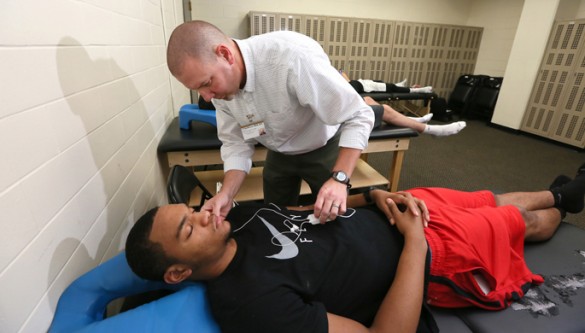
Researchers at the Vanderbilt Sports Concussion Center (VSCC) are using novel sound wave technology as part of an attempt to more rapidly and accurately diagnose sports concussions on the sidelines during games.
VSCC co-director and neurosurgeon Allen Sills, M.D., and colleagues are collecting data on athletes to devise algorithms for both non-injured and concussed brains.
The endeavor entails using a new, non-invasive device that measures intracranial pressure (ICP).
This device, called the HS-1000, could be an answer to the controversies over sports-related concussions and the quandaries about whether and when a player should go back into the game after taking a hit.
“Currently, we have to rely largely on self-report systems — what athletes are telling us as well as what we observe,” Sills said.
In gyms and on playing fields, coaches and certified athletic trainers currently have to rely on a Sport Concussion Recognition Tool. That’s basically a scorecard based on how athletes answer questions and what can be observed.
Medical professionals use a standardized tool called a SCAT3 that also relies heavily upon subjective determinations.
“What we lack with concussions is a diagnostic tool we can hook you up to and say you definitely have one or you definitely don’t,” said Tim Lee, MHA, M.S., a coordinator for the study.
The competitive nature of athletes leads many to downplay or lie about their symptoms, said Sills.
Luke Kornet, a forward on the Vanderbilt men’s basketball team, never got a chance to tell a fib after being knocked momentarily unconscious during a March game against Stanford. He said he didn’t even remember what happened.
Now, he and his teammates are putting in earbuds — one with a transmitter and the other with a receiver — to participate in the study.
The procedure takes about 12 minutes as a series of sound waves are sent through the cranial cavity.
The HS-1000 offers a radical departure from current ICP measuring methods that entail drilling into the skull for the placement of sensors. Developed by HeadSense Medical Inc., it has received regulatory approvals in Europe and Israel for ICP monitoring. The company is currently seeking U.S. Food and Drug Administration approval.
Sills is assisting the company to determine whether the device has a broader application beyond monitoring ICP. He’s checking to see if its measurements are sensitive enough to detect concussions.
The VSCC is the only site in the world conducting this study for the Israeli company, which has a U.S. office in Akron, Ohio.
Lee is gathering data from both male and female athletes between the ages of 13 and 25. Student-athletes from Battle Ground Academy in Franklin are participating in the study.
“Right now, we are just trying to burst through and get the healthy data,” Lee said. “The concussion data will just come as it comes. We have two concussed athletes in the study that we’re gathering data on. I think we have probably around 25 or 30 healthy subjects. We are trying to get 50 of each.”
The genesis of the study came about when the developers of the HS-1000 heard Sills make a presentation in Israel. They realized the device might have applications outside of a hospital setting.
“Part of our ongoing quest to improve our care for concussed athletes is to find tools that can objectively diagnose a concussion at the field of play,” Sills said.
If the Vanderbilt study shows that the device is an effective diagnostic tool for concussions, the company could obtain FDA approval for that use in the second half of 2017, said Guy Weinberg, chief executive officer of HeadSense.
With the HS-1000, the earbud set is connected to an Android-based tablet programmed with software and algorithms. The measurements of resistance from the sound waves are compared to normal ranges.
“It’s almost like you are listening to your iPod or some type of music,” Sills said.












